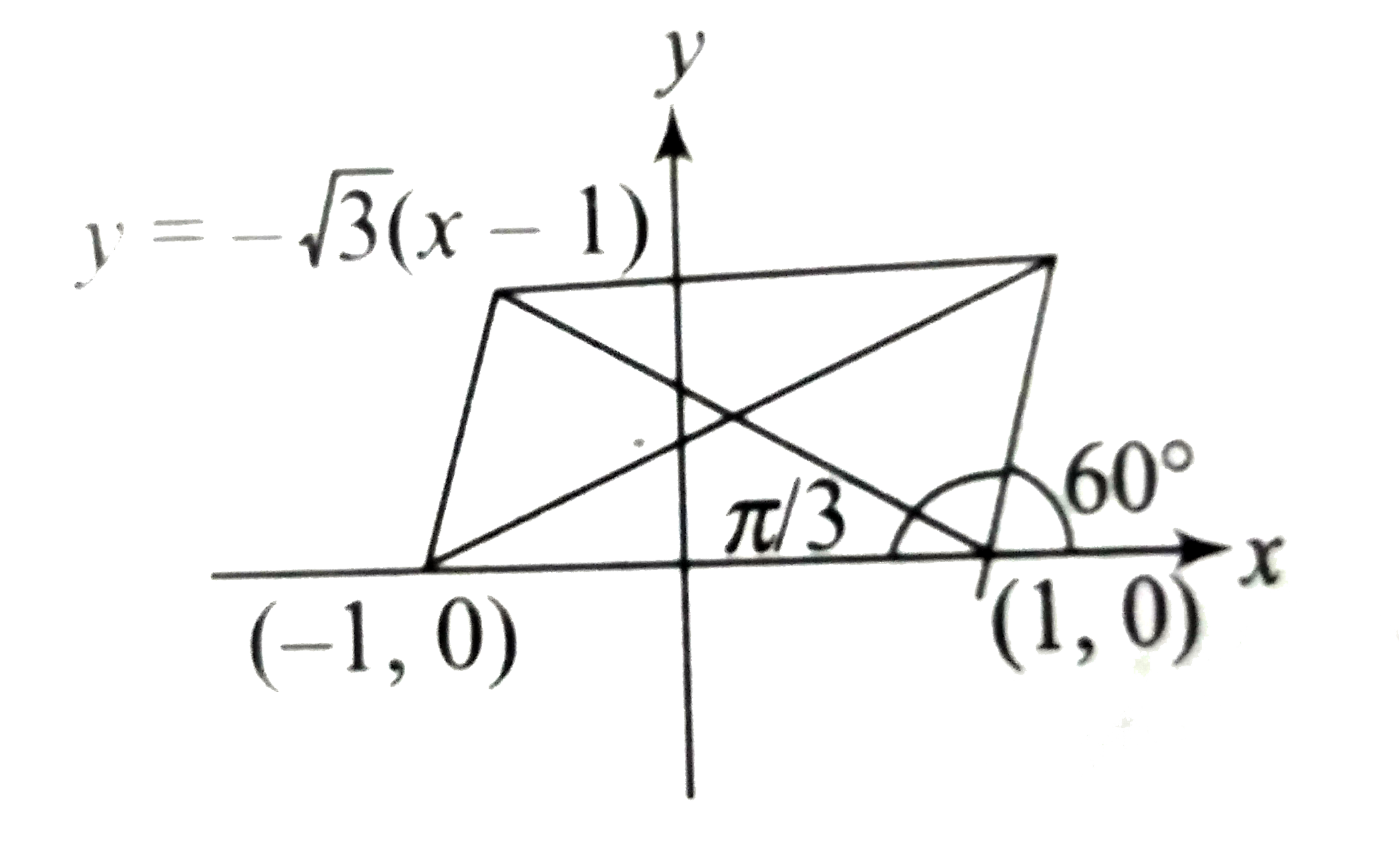The two adjacent sides of parallelogram are y = 0 and y=√3(x−1). If equation of one diagonal is √3y=(x+1), then equation of other diagonal is Solution in Bengali
A. √3y=(x−1)
B. y=√3(x+1)
C. y=−√3(x−1)
D. √3y=−(x+1)
The correct Answer is:C
y=0 is x-axis
y=√3(x−1) is line through point (1,0) and making an angle 60∘ with x-axis
√3y=(x+1) is line through point (−1,0) and making an angle 30∘ with x-axis
Draw these lines on coordinate axis

From the figure clearly another diaonal passes through the point (1,0) and having slope −√3
∴ Equation of required diagonal is y=−√3(x−1)
Topper's Solved these Questions
- BOOK - CENGAGE PUBLICATIONCHAPTER - STRAIGHT LINEEXERCISE - Multiple Correct Answers Type8videos
STRAIGHT LINE
- BOOK - CENGAGE PUBLICATIONCHAPTER - STRAIGHT LINEEXERCISE - Multiple Correct Answers Type8videos
STRAIGHT LINE
- BOOK - CENGAGE PUBLICATIONCHAPTER - STATISTICSEXERCISE - Archives10videos
STATISTICS
- BOOK - CENGAGE PUBLICATIONCHAPTER - STRAIGHT LINESEXERCISE - ARCHIVES (NUMERICAL VALUE TYPE)1videos
STRAIGHT LINES
Similar Questions
The point P(α,α+1) will lie inside the triangle whose vertices are A(0,3),B(−2,0) and C(6,1) if
05:58View SolutionThe point P(α,α+1) will lie inside the triangle whose vertices are A(0,3),B(−2,0) and C(6,1) if
06:49View SolutionIf the mean deviation of the numbers 1,1+d,1+2d,...,1+100d from their mean is 255, then the d is equal to
06:38View SolutionFor a point P in the plane, let d1(P)andd2(P) be the distances of the point P from the lines x−y=0andx+y=0 respectively. The area of the region R consisting of all points P lying in the first quadrant of the plane and satisfying 2≤d1(P)+d2(P)≤4, is
06:27View SolutionThe two adjacent one of the diagonals of the parallelogram is along the line x−y+1=0and4x−3y−2=0 If one of the diagonals of the parallelogram is along the line y=3x2, then the other diagonal has
View SolutionThe two adjacent sides of parallelogram are y = 0 and y=√3(x−1). If equation of one diagonal is √3y=(x+1), then equation of other diagonal is
12:16View SolutionTwo sides of a parallelogram are x+y+1=0&2x-y+2=0. One of its diagonal is 13x-2y-32=0 Equation of other diagonal is
04:33View SolutionIf the lines ax2+2hxy+by2=0 be two sides of a parallelogram and the line lx+my=1 be one of its diagonal, show that the equation of the other diagonal is y (bl-hm)=x(am-hl).
03:01View Solutionकिसी समान्तर चतुर्भुज कि दो आसन्न भुजाओ के समीकरण 4x+5y=0 और 7x+2y=0 है । यदि उसके एक विकर्ण का समीकरण 11x+7y=9 है , तो उसके एक विकर्ण का समीकरण है , तो उसके एक विकर्ण का समीकरण ज्ञात कीजिए
07:58View Solutionसाबित करें कि √3x+y=0,√3y+x=0√3x+y=1 तथा √3y+x=1 से बने समात चतुर्भुज के विकर्ण एक-दूसरे पर लंब हैं।
07:47View SolutionThe equations of the sides of a parallelogram are x = 2, x = 3 and y = 1, y = 5. Equations to the pair of diagonals are
04:47View SolutionThe two adjacent sides of parallelogram are y = 0 and y=√3(x−1). If equation of one diagonal is √3y=(x+1), then equation of other diagonal is
05:48View SolutionTwo adjacent sides of a parallelogram 4x +5y =0 and 7x +2y =0 is. If the equation of a diagonal 11 x +7y =9 If, the equation of the second diagonal is
06:06View SolutionThe adjacent sides of a parallelogram are 2x2−5xy+3y2=0 and one diagonal is x + y + 2 = 0. Find the vertices and the other diagonal.
07:46View SolutionIf 2x2−5xy+3y2=0 represents two adjacent sides of a parallelogram and x+y+2=0 is equation of one of diagonal then other diagonal is
08:47View SolutionProve that the disgonals of the parallelogram whose sides are √3x+y=0,√3y+x=0,'sqrt3x+y=1'and √3y+x=1are perpendicular to each other.
07:47View Solution

